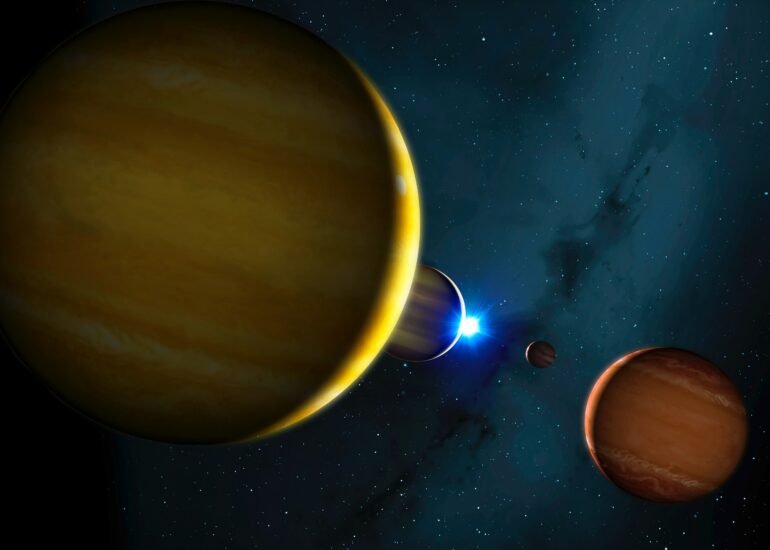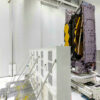Communications across the vastness of interstellar space could be enhanced by taking advantage of a star’s ability to focus and magnify communication signals. A team of graduate students at Penn State is looking for just these sorts of communication signals that might be taking advantage of our own sun if transmissions were passing through our solar system.
A paper describing the technique—explored as part of a graduate course at Penn State covering the Search for Extraterrestrial Intelligence (SETI)—has been accepted for publication in The Astronomical Journal and is available on the preprint server arXiv.
Massive objects like stars and black holes cause light to bend as it passes by due to the object’s gravitational pull, according to Einstein’s Theory of General Relativity. The warped space around the object acts somewhat like a lens of a telescope, focusing and magnifying the light—an effect called gravitational lensing.
“Astronomers have considered taking advantage of gravitational lensing as a way to essentially build a giant telescope to look at planets around other stars,” said Jason Wright, professor of astronomy and astrophysics at Penn State who taught the course and is director of the Penn State Extraterrestrial Intelligence Center. “It has also been considered as a way that humans might communicate with our own probes if we ever sent them to another star. If an extraterrestrial technological species were to use our sun as a lens for interstellar communication efforts, we should be able to detect those communications if we look in the right place.”
Because communications across interstellar distances would face a variety of challenges related to transmission power and fidelity across such vast expanses, the researchers believe any communication efforts would likely involve a network of probes or relays, like cellular telephone towers in space. In this study, they looked to one of our nearest stars, which should be the closest node in a communication network.
“Humans use networks to communicate across the world all the time,” said Nick Tusay, a graduate student in the course who helped lead the project. “When you use a cell phone, the electromagnetic waves are transmitted to the nearest cellular tower, which connects to the next tower and so on. TV, radio, and internet signals also take advantage of network communication systems, which have many advantages over point-to-point communications. On an interstellar scale, it makes sense to use stars as lenses, and we can infer where probes would need to be located in order to use them.”
In this study, the researchers looked more than 550 times the Earth-sun distance opposite the sky from Alpha Centauri—the closest stars to our own system that might be the nearest node in a communications network—which is where a probe would be located in our solar system in order to use the sun as a lens. This enabled the researchers to potentially detect radio transmissions that might be signals sent directly to Earth to communicate with us, signals being sent to other probes exploring the solar system, or perhaps even signals being sent through the gravitational lens back to Alpha Centauri.
“There have been a few previous searches using optical wavelengths, but we chose to use radio wavelengths, because radio is a great way to communicate information across space,” said Macy Huston, a graduate student in the course who helped lead the project. “We included what is known as the ‘waterhole’ wavelengths, which are often a focus of SETI searches because they would be an ideal part of the radio spectrum to communicate in and could act like a waterhole on Earth, where many species convene. These wavelengths are generally free from other radio waves coming from cosmic objects, so it’s a clean part of the spectrum to communicate in.”
Investigating these particular wavelengths also allowed the researchers to maximize the amount of data they could collect across the sky in a short window of time. The student researchers collected the data over one night when they visited the Green Bank Telescope in West Virginia. Their data collection and analysis were conducted in collaboration with Breakthrough Listen, a program dedicated to finding evidence of intelligent life beyond Earth.
The students did not detect any signals in the wavelengths they investigated that might be of extraterrestrial origin in the area they observed, suggesting that signals at these wavelengths were not being sent towards Earth during the brief window when they were looking.
“Our search was limited to one night, so anything that wasn’t broadcasting while we were observing was not going to get picked up,” said Tusay. “Although our limited search could miss existing probes if they weren’t constantly broadcasting at these frequencies, this was a good test to see if this kind of search is possible.”
The researchers suggest that extending their search to include additional observations, or observations directed at other nearby stars or other frequencies, could still prove fruitful. One of the students in the class is currently exploring archival data to see if previous Breakthrough Listen observations have pointed at additional areas that might be optimal for probes making use of the gravitational lens effect.
“The lensing effect isn’t the most robust at these frequencies, though there are still good reasons these frequencies might be used,” said Huston. “But we believe the technique is sound and hope that students in the course in future years might expand on our search.”
The graduate-level SETI course is one of only two in the world—the other at the University of California, Los Angeles—that encourages graduate students to conduct a radio-based SETI research project and to publish their results in a scientific journal.
“This graduate course is the centerpiece of the Penn State Center for Extraterrestrial Intelligence,” said Wright. “Students come from a variety of disciplines, including astrobiology, astronomy, chemistry, and geophysics. This year, because it was a hybrid class, we even had a student from another university join us. One of the neat things about this class is that, because the SETI field is so young, it is possible for students to make a real contribution and publish research. It’s remarkable.”
The research was presented June 29 at Penn State’s first SETI Symposium in State College, Pennsylvania.
More information:
Nick Tusay et al, A Search for Radio Technosignatures at the Solar Gravitational Lens Targeting Alpha Centauri. arXiv:2206.14807v1 [astro-ph.IM], arxiv.org/abs/2206.14807
Provided by
Pennsylvania State University
Citation:
Could we eavesdrop on communications that pass through our solar system? (2022, July 6)



